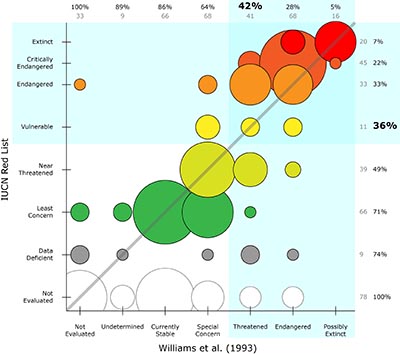|
The thing to know about Lemiox rimosus is that it is endangered. It is one of those American mussels that is limited to the Cumberland Plateau, and even within that endemic range, extant populations are disjunct between the Duck River and the tributaries of the upper Tennessee River (IUCN Red List Account, Jones et al., 2010).
This got us thinking about the imperiled conservation status of the Nearctic freshwater mussel species in general (301 species) and the current state of the available information. Williams et al. (1993) produced an excellent assessment of North American mussel species, and that article is the source of the often-cited statistic that more than 70% of freshwater American freshwater mussels are endangered or declining. Nowadays, there are Internet initiatives to keep track of those data, such as NatureServe and the IUCN Red List, and we wondered about the progress of those efforts and any updates in conservation status that might have happened in the last 23 years. Since we have collaborated in various capacities with the IUCN (and because the NatureServe Explorer refused to load in a timely manner the day we were writing this), we decided to focus on the Red List.

Comparison of conservation status assessments from the IUCN Red List and Williams et al. (1993). Click here to see an enlarged version of the chart along with the methods. |
This chart summarizes the species conservation assessments by Williams et al. (1993) and the IUCN Red List. The size of the circles is proportional to the number of species that fall into the ranks of each assessment, and the colors correspond to the IUCN status (and just class-up the whole thing). For all assessment ranks, the marginal totals of the number of species are provided, as are the cumulative percentages (beginning with the % extinct species and progressing through the rest of ranks). Circles above the diagonal reflect an escalation in conservation status (i.e., more threatened) from Williams et al. (1993) to the Red List, and those below indicate demotions.
Though the titles of the categories between the two assessments differ, their alignment is trivial. The Red List Threatened ranks are Vulnerable, Endangered, Critically Endangered, and Extinct, and these correspond to Threatened, Endangered, and Possibly Extinct. According to the Williams et al. (1993) assessments, 42% of the 301 freshwater mussel species in North America are in the Threatened ranks, whereas the Red List lists 36%. If the tally of species-to-be-worried-about is expanded to include Special Concern and Near Threatened, the Williams et al. and Red List percentages grow to 64% and 49%, respectively — both less than the previous summary statistic of >70%.
The Williams et al. percentage in 2016 (64%) is less than that of Williams et al. (1993) (>70%), and the Red List value is even lower (49%). This is easy to explain: 1) some species have improved in conservation status (e.g., 23 species have moved from Special Concern to Least Concern — Hooray!), and 2) the taxonomy has changed (summarized in Graf & Cummings, 2007 and updated here) so not all species have even been recently assessed. Seventy-eight species have not been evaluated for the Red List, and nine that have been assessed are labeled as Data Deficient (78 + 9 = 87; 29% of 301 species). The taxonomy has changed enough in the last two decades — even for the best-studied freshwater mussel assemblage in the world — that there are 33 currently-recognized species that were not evaluated back in 1993!
The upshot is that if we apply the current standard of dividing biodiversity into threatened, not/less threatened, and unknown species, then about 40% of the North American freshwater mussel species are threatened.
That nearly a third of the North American freshwater mussel assemblage is missing from the IUCN Red List might seem like a lot, but the dataset for the Nearctic region is the most complete in the world. Africa is the next most complete ((12 not evaluated + 16 data deficient) / 79 species = 35%). The most incomplete? Australasia ((2 + 3) / 30 = 77%) and the Neotropics ((6 + 14) / 217 = 89%).
Watch this web site for updates to conservation assessments as they become available. |